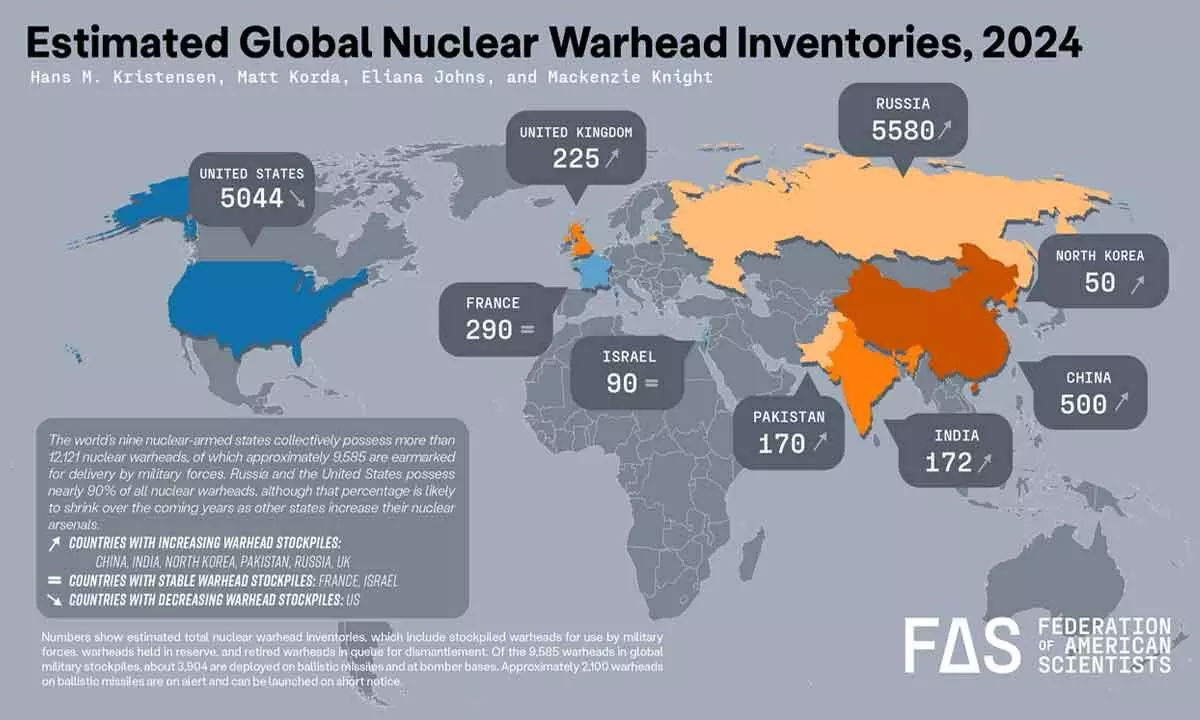Nuclear arsenals being strengthened around the world
For the first time, China is believed to have some warheads on high operational alert
image for illustrative purpose

While Pakistan remains the main focus of India’s nuclear deterrent, India appears to be placing growing emphasis on longer-range weapons, including those capable of reaching targets throughout China
The nine nuclear-armed states—the United States, Russia, the United Kingdom, France, China, India, Pakistan, the Democratic People’s Republic of Korea (North Korea) and Israel—continued to modernize their nuclear arsenals and several of them deployed new nuclear-armed or nuclear-capable weapon systems last year.
Of the total global inventory of an estimated 12,121 warheads in January 2024, about 9585 were in military stockpiles for potential use. An estimated 3904 of those warheads were deployed with missiles and aircraft—60 more than in January 2023—and the rest were in central storage. Around 2100 of the deployed warheads were kept in a state of high operational alert on ballistic missiles. Nearly all of these warheads belonged to Russia or the USA, but for the first time China is believed to have some warheads on high operational alert.
‘While the global total of nuclear warheads continues to fall as cold war-era weapons are gradually dismantled, regrettably we continue to see year-on-year increases in the number of operational nuclear warheads,’ said SIPRI Director Dan Smith, while adding. ‘This trend seems likely to continue and probably accelerate in the coming years and is extremely concerning.’
India, Pakistan and North Korea are all pursuing the capability to deploy multiple warheads on ballistic missiles, something Russia, France, the UK, the USA and—more recently—China already have. This would enable a rapid potential increase in deployed warheads, as well as the possibility for nuclear-armed countries to threaten the destruction of significantly more targets.
Russia and the USA together possess almost 90 per cent of all nuclear weapons. The sizes of their respective military stockpiles like usable warheads seem to have remained relatively stable in 2023, although Russia is estimated to have deployed around 36 more warheads with operational forces than in January 2023.
Transparency regarding nuclear forces has declined in both countries in the wake of Russia’s full-scale invasion of Ukraine in February 2022 and debates around nuclear-sharing arrangements have increased in saliency.
Notably, there were several public claims made in 2023 that Russia had deployed nuclear weapons on Belarusian territory, although there is no conclusive visual evidence that the actual deployment of warheads has taken place.
In addition to their military stockpiles, Russia and the USA each hold more than 1200 warheads previously retired from military service, which they are gradually dismantling.
SIPRI’s estimate of the size of China’s nuclear arsenal increased from 410 warheads in January 2023 to 500 this January and it is expected to keep growing. For the first time, China may also now be deploying a small number of warheads on missiles during peacetime. Depending on how it decides to structure its forces, China could potentially have at least as many intercontinental ballistic missiles (ICBMs) as either Russia or the USA by the turn of the decade, although its stockpile of nuclear warheads is still expected to remain much smaller than the stockpiles of either of those two countries.
Although the UK is not thought to have increased its nuclear arsenal in 2023, its warhead stockpile is expected to grow in the future as a result of the British government’s announcement in 2021 that it was raising its limit from 225 to 260 warheads. The government also said it would no longer publicly disclose its quantities of nuclear weapons, deployed warheads or deployed missiles.
In 2023 France continued its programmes to develop a third-generation nuclear-powered ballistic missile submarine (SSBN) and a new air-launched cruise missile, as well as to refurbish and upgrade existing systems.
India slightly expanded its nuclear arsenal in 2023. Both India and Pakistan continued to develop new types of nuclear delivery systems in 2023. While Pakistan remains the main focus of India’s nuclear deterrent, India appears to be placing growing emphasis on longer-range weapons, including those capable of reaching targets throughout China.
North Korea continues to prioritize its military nuclear programme as a central element of its national security strategy. SIPRI estimates that the country has now assembled around 50 warheads and possesses enough fissile material to reach a total of up to 90 warheads, both significant increases over the estimates for January 2023. While North Korea conducted no nuclear test explosions in 2023, it appears to have carried out its first test of a short-range ballistic missile from a rudimentary silo. It has also completed development of at least two types of land-attack cruise missile (LACM) designed to deliver nuclear weapons.
Israel, which does not publicly acknowledge possessing nuclear weapons, is also believed to be modernizing its nuclear arsenal and appears to be upgrading its plutonium production reactor site at Dimona.

